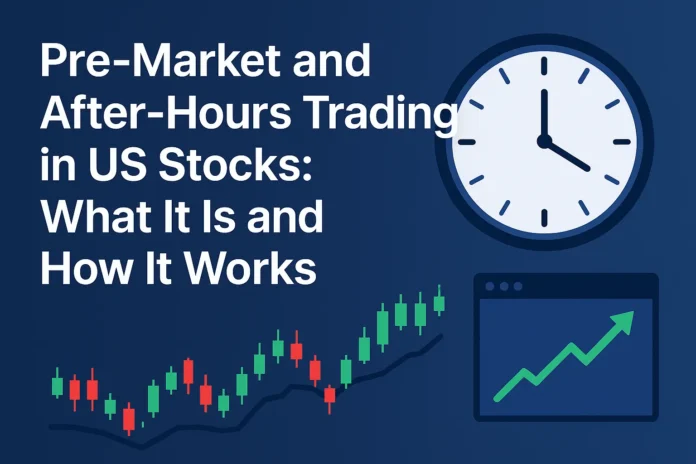Extended-hours trading has transformed how investors approach the stock market, offering opportunities beyond the traditional 9:30 AM to 4:00 PM ET session. Whether you’re looking to react to breaking news or position yourself ahead of market movements, understanding pre-market and after-market trading is essential for modern investors.
What Is Pre-Market Trading?
Pre-market trading represents the early hours of stock market activity, occurring before the regular trading session begins. During this time, traders and institutions actively respond to overnight developments, international market movements, and breaking news that could impact stock prices.
Pre-Market Trading Hours and Features
Timing: Pre-market sessions begin as early as 4:00 AM ET, with trading activity typically intensifying around 8:00 AM ET as more participants enter the market.
Trading Platforms: Unlike regular hours, pre-market trades execute through Electronic Communication Networks (ECNs) rather than traditional stock exchanges. This alternative infrastructure enables early trading but comes with distinct characteristics.
Liquidity Considerations: Pre-market sessions experience significantly lower trading volumes compared to regular hours. This reduced liquidity creates wider bid-ask spreads, increasing the cost of entering and exiting positions.
Market Participants: The pre-market attracts institutional investors, active day traders, and retail investors seeking early positioning opportunities.
Benefits of Pre-Market Trading
Immediate News Response: Pre-market trading empowers investors to act on overnight news, corporate earnings announcements, or geopolitical developments before the broader market reacts. This early access can provide significant advantages when unexpected events occur.
Strategic Position Building: Traders can establish positions ahead of anticipated market movements, potentially capturing favorable entry points before regular trading volume increases prices.
Market Sentiment Gauge: Pre-market activity offers valuable insights into market direction and investor sentiment, helping traders anticipate how stocks might perform during regular hours.
Pre-Market Trading Risks
Enhanced Volatility: Price swings in pre-market sessions can be dramatic due to limited liquidity and fewer market participants, creating both opportunities and risks.
Execution Challenges: Lower trading volumes mean orders may not execute at desired prices, or may only partially fill, complicating trade execution strategies.
Access Limitations: Not all brokerage platforms support pre-market trading, and those that do may impose specific restrictions on order types or trading hours.
What Is After-Market Trading?
After-market trading extends market access beyond the closing bell, allowing investors to trade for several hours after the regular session ends. Companies frequently schedule earnings releases and major announcements during this period, making after-hours trading particularly relevant for active investors.
After-Market Trading Hours and Features
Timing: After-market sessions run from 4:00 PM to 8:00 PM ET, providing four hours of extended trading opportunity.
Trading Infrastructure: Similar to pre-market sessions, after-market trading operates through Electronic Communication Networks (ECNs).
Liquidity Profile: After-hours sessions share the lower liquidity characteristics of pre-market trading, resulting in wider spreads and increased execution risks.
Active Participants: Institutional traders, active retail investors, and portfolio managers utilize after-market sessions to adjust positions based on late-breaking information.
Advantages of After-Market Trading
Earnings Report Response: With most companies releasing quarterly earnings after market close, after-hours trading enables immediate reaction to financial results and guidance updates.
Global Event Trading: International developments occurring after US market hours can significantly impact stock prices. After-market trading allows investors to respond without waiting until the next trading day.
Portfolio Management: Investors can make strategic adjustments based on the day’s market action and new information that emerges after the closing bell.
After-Market Trading Risks
Reduced Liquidity Impact: Fewer active traders during after-hours sessions create wider bid-ask spreads, potentially increasing trading costs.
Price Volatility: Significant price movements are common in after-market trading due to lower participation and concentrated trading around specific news events.
Order Type Restrictions: Many brokers limit available order types during extended hours, often restricting traders to limit orders only.
Pre-Market and After-Market Trading for Indian Investors
Indian investors can participate in US extended-hours trading, opening access to American markets beyond traditional boundaries. However, the time zone difference creates unique considerations.
Trading Hours in Indian Standard Time
Understanding the converted time zones is crucial for Indian investors:
- Pre-Market: Approximately 1:30 PM to 9:30 PM IST
- Regular Market: Approximately 7:00 PM to 1:30 AM IST
- After-Market: Approximately 1:30 AM to 5:30 AM IST
Note: These timings shift when the United States transitions between Daylight Saving Time and Standard Time, typically occurring in March and November.
Important Considerations for Indian Traders
Limit Order Requirement: Due to the lower liquidity in extended-hours sessions, Indian investors can typically only place limit orders, ensuring price control and execution certainty.
Regulatory Compliance: Trades execute through US-regulated platforms, providing investor protection and ensuring compliance with American securities regulations.
Strategic Timing: Extended-hours access enables Indian investors to react immediately to earnings announcements, breaking news, or global events without waiting for the next regular session.
Essential Tips for Extended-Hours Trading Success
Successfully navigating pre-market and after-market sessions requires discipline and strategic planning. Here are proven strategies for extended-hours trading:
1. Always Use Limit Orders
Market orders during extended hours can result in unexpected execution prices due to low liquidity. Limit orders provide price control, ensuring you don’t overpay or undersell your positions.
2. Stay Informed and Prepared
Monitor overnight developments, scheduled earnings releases, and international market movements. Set up news alerts for positions you’re watching, and understand the catalysts that might move stocks during extended hours.
3. Understand Your Platform’s Rules
Brokerage platforms vary significantly in their extended-hours offerings. Some brokers restrict available stocks, limit order sizes, or impose additional fees. Review your broker’s specific rules before trading.
4. Implement Strict Risk Management
Extended-hours volatility demands conservative position sizing. Consider using smaller trade sizes than you would during regular hours, and avoid overleveraging your portfolio during these unpredictable sessions.
5. Monitor Bid-Ask Spreads Carefully
Wide spreads can significantly impact profitability. Calculate the spread as a percentage of the stock price before entering trades, and avoid positions where the spread exceeds your acceptable cost threshold.
Should You Trade During Extended Hours?
Extended-hours trading isn’t suitable for every investor. Consider these factors when deciding whether pre-market and after-market sessions align with your investment strategy:
Best for: Active traders, investors responding to specific news events, portfolio managers making strategic adjustments, and those with experience handling volatility.
Less suitable for: Long-term buy-and-hold investors, beginners unfamiliar with market mechanics, and those unable to actively monitor positions during extended hours.
Conclusion: Maximizing Extended-Hours Opportunities
Pre-market and after-market trading sessions provide valuable opportunities for informed investors to act on news, adjust positions strategically, and gain insights into market sentiment before regular trading begins. These extended hours democratize market access and enable faster response to market-moving events.
However, the benefits come with elevated risks. Lower liquidity, increased volatility, and execution challenges demand careful planning and disciplined risk management. Whether you’re an Indian investor navigating time zone differences or a domestic trader seeking early positioning advantages, success in extended-hours trading requires preparation, knowledge, and respect for the unique dynamics of these sessions.
By understanding the mechanics, implementing proper strategies, and managing risk appropriately, investors can leverage pre-market and after-market trading to enhance their overall market approach and capitalize on opportunities that exist beyond traditional trading hours.


